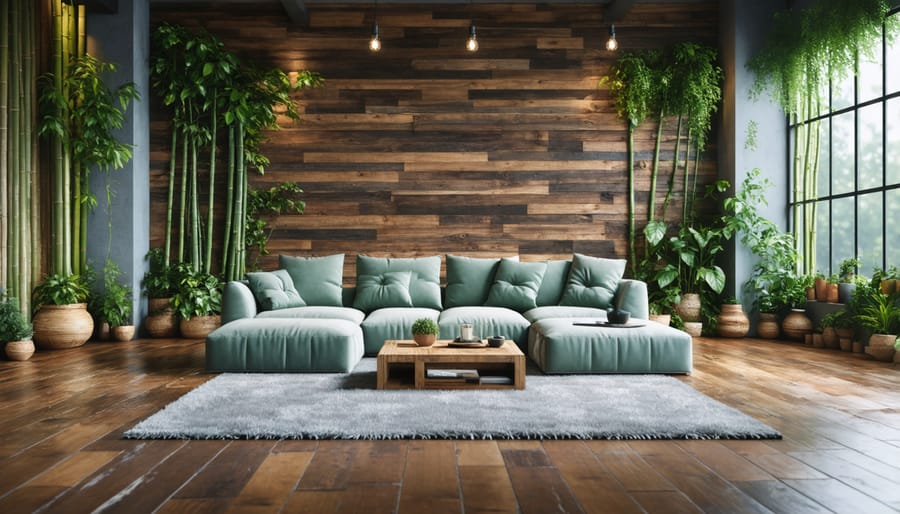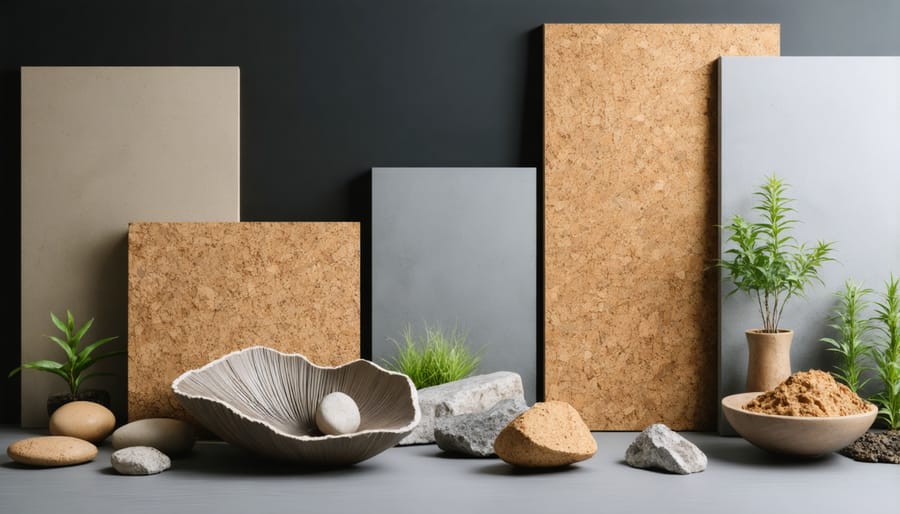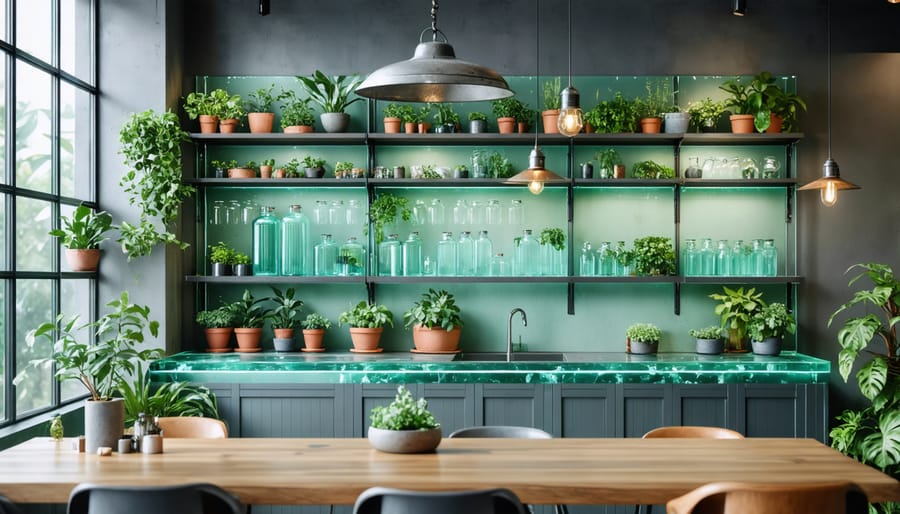Transform your living spaces with sustainable materials that embody biophilic design principles while reducing your environmental footprint. Reclaimed wood flooring, bamboo wall panels, and recycled glass countertops now rival their traditional counterparts in both aesthetics and durability, offering eco-conscious designers limitless creative possibilities. Modern green materials blend seamlessly with contemporary design trends, incorporating natural textures, sustainable certifications, and non-toxic finishes that protect both your family’s health and the planet. From cork flooring that dampens sound to mushroom-based wall installations that purify air, today’s eco-friendly interior materials don’t just minimize environmental impact—they actively contribute to healthier, more vibrant living spaces. Whether you’re planning a complete renovation or simply updating accent pieces, choosing green materials ensures your design decisions support both personal wellness and environmental sustainability.
Natural and Recycled Wood: The Foundation of Green Design

Reclaimed Wood Features
Reclaimed wood brings character and sustainability to your interior spaces while preserving our forests. Sourced from old barns, warehouses, and retired shipping materials, each piece tells a unique story through its weathered patterns and rich patina. This eco-friendly material not only reduces landfill waste but also requires minimal processing compared to new lumber.
Popular applications include statement walls, exposed ceiling beams, and custom furniture pieces. For a modern twist, try incorporating reclaimed wood floating shelves in your kitchen or bathroom, or create an eye-catching headboard for your bedroom. The material’s versatility allows it to work in both rustic and contemporary settings.
When selecting reclaimed wood, look for reliable suppliers who can verify the wood’s origin and ensure it’s been properly treated for indoor use. Keep in mind that some pieces may need additional cleaning or sealing before installation. While the cost might be higher than new wood, the environmental benefits and unique aesthetic make it a worthwhile investment.
Pro tip: Mix different wood tones and textures to create visual interest, but maintain consistency within each individual project for a cohesive look.
FSC-Certified Wood Options
When it comes to sustainable wood options, FSC-certified materials are the gold standard for eco-conscious interior design. The Forest Stewardship Council (FSC) certification ensures that wood products come from responsibly managed forests that provide environmental, social, and economic benefits.
Look for the FSC label when shopping for hardwood flooring, furniture, cabinetry, or decorative elements. Popular FSC-certified wood species include oak, maple, bamboo, and walnut. These materials not only bring natural warmth to your space but also help protect forest ecosystems and support sustainable forestry practices.
Many major retailers now offer FSC-certified options, making it easier than ever to find sustainable wood products. When shopping, you might notice slightly higher prices compared to non-certified alternatives, but consider it an investment in both your home and the environment.
Pro tip: Ask your contractor or supplier for documentation proving FSC certification. Some manufacturers may claim sustainability without proper certification, so it’s important to verify. Also, consider reclaimed or salvaged wood as an alternative – these options often come with unique character and history while reducing the demand for new timber.
Remember, choosing FSC-certified wood helps ensure our forests will continue to thrive for generations to come.
Plant-Based Materials Making Waves
Bamboo and Cork Solutions
When it comes to eco-friendly home decor solutions, bamboo and cork stand out as sustainable superstars. These rapidly renewable materials offer both style and environmental benefits, making them perfect choices for conscious homeowners.
Bamboo, known for its incredible growth rate of up to 3 feet per day, can be harvested every 3-5 years without damaging the plant. This makes it an excellent alternative to hardwoods, which can take decades to mature. In your home, bamboo shines in flooring, offering a warm, durable surface that’s harder than oak. You’ll also find stunning bamboo options for wall panels, cabinet fronts, and even window blinds.
Cork, harvested from the bark of cork oak trees every 9-12 years without harming the tree, brings unique texture and warmth to your spaces. Its natural properties make it perfect for flooring – it’s soft underfoot, naturally antimicrobial, and provides excellent insulation. Try cork wall tiles for a striking accent wall, or explore cork furniture pieces for added character.
Both materials are incredibly versatile and easy to maintain. For bamboo flooring, regular sweeping and occasional damp mopping will keep it looking fresh. Cork surfaces need similar care, plus periodic resealing to maintain their water resistance. When shopping, look for FSC-certified products to ensure responsible sourcing and support sustainable forestry practices.
Hemp and Mycelium Products
Hemp and mycelium are revolutionizing sustainable interior design with their incredible versatility and eco-friendly properties. Hemp-based materials, derived from the fast-growing Cannabis sativa plant, are becoming increasingly popular for everything from wall panels to insulation. These materials offer exceptional durability while being naturally resistant to mold and pests.
What makes hemp particularly appealing is its negative carbon footprint – it actually absorbs more CO2 during growth than it releases during processing. Hemp-based materials also provide excellent thermal and acoustic insulation, making them perfect for creating comfortable, energy-efficient spaces.
Mycelium, the root structure of mushrooms, is another game-changing material. When combined with agricultural waste, it creates sturdy, lightweight panels and furniture pieces that are completely biodegradable. Think of it as nature’s own building blocks – these living materials can be grown into custom shapes and sizes, offering endless design possibilities.
Both hemp and mycelium products are naturally fire-resistant and don’t off-gas harmful chemicals, making them safer alternatives to traditional synthetic materials. For DIY enthusiasts, hemp-based products like hemp-lime plaster are relatively easy to work with and can be used for various projects, from accent walls to decorative elements.
When shopping for these materials, look for certified products from reputable manufacturers who can provide detailed information about sourcing and processing methods. While these materials might cost slightly more upfront, their durability and environmental benefits make them a worthwhile investment for any eco-conscious home makeover.

Recycled and Upcycled Materials
Glass and Metal Applications
Recycled glass and metal components offer stunning sustainable options for modern interiors while reducing environmental impact. Glass from bottles and windows can be transformed into beautiful countertops, backsplashes, and decorative tiles that add sparkle and character to any room. These recycled glass surfaces come in various colors and patterns, from subtle sea-glass effects to bold mosaic designs.
For a unique lighting feature, consider pendant lamps made from repurposed glass bottles or industrial fixtures crafted from salvaged metal. These pieces add personality while telling a sustainability story. Recycled aluminum and steel are increasingly popular for furniture frames, cabinet hardware, and decorative accents, offering durability with a reduced carbon footprint.
Metal recycling has come a long way, with salvaged materials finding new life as statement wall panels, room dividers, and artistic installations. Look for pieces that combine recycled metals with other sustainable materials like reclaimed wood for an eco-chic industrial look.
When shopping for glass and metal elements, ask about the recycled content percentage and sourcing. Many manufacturers now offer certification of their recycled materials, ensuring you’re making a genuinely sustainable choice. Remember that these materials are not just environmentally friendly – they’re also incredibly durable and can last for decades with proper care.

Plastic-Based Products
The world of recycled plastic products has undergone a remarkable transformation in recent years, offering stunning and sustainable options for your home. From sleek countertops made of recycled bottles to stylish outdoor furniture crafted from ocean-bound plastics, these innovative materials prove that eco-friendly choices can be both beautiful and practical.
Consider incorporating recycled plastic tiles for a unique backsplash or accent wall. These tiles come in various colors and patterns, often mimicking natural materials like stone or wood, while giving plastic waste a second life. For flooring solutions, recycled PET carpet tiles offer durability and style while helping reduce plastic pollution.
Decorative elements made from recycled plastics are gaining popularity too. Look for pendant lights crafted from recycled milk jugs, decorative wall panels made from compressed plastic waste, and even textured window treatments created from recycled materials. These pieces often become conversation starters while supporting environmental sustainability.
When selecting plastic-based products, look for certifications that verify recycled content and ensure the manufacturing process is environmentally responsible. Many manufacturers now provide transparent information about their sourcing and production methods, helping you make informed decisions for your eco-friendly interior design project.
Natural Fiber Textiles and Finishes
Organic Fabrics
When it comes to natural materials in design, organic fabrics are leading the way in sustainable interior choices. Cotton, hemp, and linen stand out as excellent eco-friendly options for your home textiles. Organic cotton, grown without harmful pesticides, offers breathability and comfort perfect for curtains, upholstery, and bedding. Hemp is particularly impressive, requiring minimal water to grow while producing durable, naturally antimicrobial fabric that gets softer with each wash.
Consider bamboo fabric for its silky texture and quick-growing renewable source. It’s excellent for window treatments and throws, though be sure to verify it’s processed using eco-friendly methods. Wool, when sourced from responsible farmers, provides natural insulation and fire resistance, making it ideal for carpets and heavy curtains.
For smaller accent pieces, look for textiles made from recycled materials or those certified by GOTS (Global Organic Textile Standard). These fabrics not only contribute to a healthier home environment but also support sustainable farming practices and responsible manufacturing processes.
Non-Toxic Finishes
When it comes to creating a healthier home environment, non-toxic finishes are a game-changer. Traditional paints and varnishes often contain harmful VOCs (volatile organic compounds) that can off-gas for years, but today’s eco-friendly alternatives offer beautiful results without the health risks.
Look for zero-VOC or low-VOC paints from reputable brands, which are now available in virtually any color you can imagine. These water-based options provide excellent coverage while being safe for your family and the environment. Natural milk paint, made from milk protein and lime, offers a beautiful matte finish that’s perfect for creating a vintage look.
For wood surfaces, consider natural oils like linseed, tung, or hemp oil. These penetrating finishes enhance the wood’s natural beauty while providing protection without harmful chemicals. Beeswax-based finishes are another excellent option, especially for furniture and decorative pieces.
When selecting clear coats or sealants, opt for water-based polyurethane or natural shellac. These provide durability and protection while maintaining indoor air quality. Remember to check for third-party certifications like GREENGUARD or Green Seal to ensure the products meet strict environmental standards.
Practical Implementation Tips
Getting started with green materials doesn’t have to be overwhelming or expensive. Begin by identifying one area of your home where you’d like to make sustainable changes, similar to how you might approach budget-friendly room transformations. Start small by swapping out conventional items with eco-friendly alternatives as they need replacement.
When shopping for furniture, look for FSC-certified wood pieces or those made from reclaimed materials. Many manufacturers now clearly label their sustainable products, making them easier to identify. Consider refinishing existing furniture instead of buying new – a fresh coat of low-VOC paint or natural oil can work wonders.
For walls and floors, begin with low-VOC or zero-VOC paints in high-traffic areas. If you’re planning to replace flooring, start in smaller spaces like bathrooms or entryways with sustainable options like cork or bamboo. This allows you to test how these materials perform in your space before making larger commitments.
Textiles are an easy entry point – swap out conventional throw pillows and blankets with organic cotton, hemp, or recycled fabric alternatives. When replacing window treatments, choose natural fibers or recycled materials.
Keep a materials library of sustainable samples, noting prices and suppliers. This helps you plan future upgrades and track your progress. Remember to properly dispose of old materials – many can be donated or recycled. Where possible, work with local suppliers and artisans who can provide sustainable materials while supporting your community.
Track the performance of your green materials over time, noting durability, maintenance needs, and any impact on your home’s comfort level. This information will help guide future sustainable design choices.
Embracing green materials in your interior design isn’t just a trend – it’s a meaningful step toward creating healthier, more sustainable living spaces. From reclaimed wood and bamboo to recycled glass and natural fibers, each eco-friendly choice contributes to both environmental preservation and your home’s unique character. Remember that sustainable design doesn’t mean compromising on style or functionality; today’s green materials offer endless possibilities for creating beautiful, comfortable spaces.
By choosing cork flooring, low-VOC paints, or salvaged materials, you’re not only reducing your environmental footprint but also investing in your family’s well-being. Start small by incorporating one or two sustainable elements, then gradually expand your eco-friendly choices as you become more comfortable with green design principles.
The future of interior design is undoubtedly green, and every sustainable choice matters. Whether you’re planning a complete renovation or simply refreshing a room, consider the environmental impact of your design decisions. Your home can be both beautiful and environmentally responsible – it’s all about making informed choices that align with your values and aesthetic preferences.
